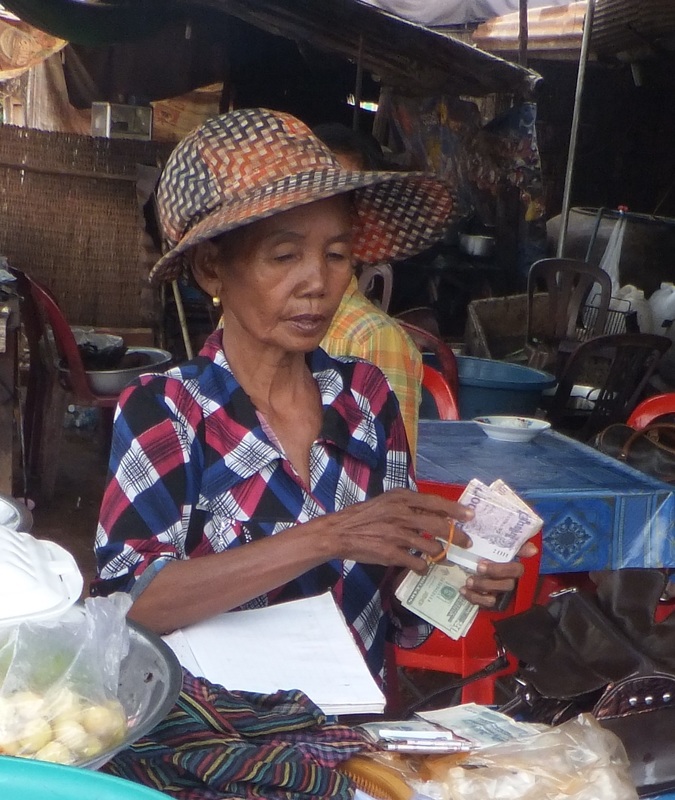|
Microloans once seemed like the ideal solution to poverty. Lending the ultra-poor money to start or expand their own microenterprise to lift themselves out of poverty was an attractive proposition. For a long time microfinance was untouchable and unchallenged but now the gloss has come off and there is a growing realisation that microcredit actually harms the ultra-poor via indebtedness and unsustainable spending on consumption. We're seeing the adverse impact of microfinance programmes first-hand in Chhouk. Cambodia has one of the fastest growing microfinance sectors globally with 45 organisations (including NGOs) providing small loans to 1.8 million borrowers. Borrowing from multiple sources is common and competition for clients is intense. Most franchisees coming into our programme are current or past microloan borrowers and many struggle to repay loans with interest rates of up to 40% per annum. Here are some recent examples of microfinance impacting franchisees in our programme: 1) Two franchisees, (mother and daughter) recently opted to leave our programme and move to Phnom Penh, (the capital city) to work in construction (the most unsafe industry in Cambodia with no worker protection laws) because they could not afford to pay weekly microloan repayments owed to two microloan agencies (one of which is the microfinance arm of an international aid organisation operating in NZ). They had used loan money for living costs and housing materials not income generation. 2) Another franchisee with microloan debt has also opted to leave our programme as he is frequently away from his village working in a different area breaking up rocks to earn extra money, and is therefore not around enough to look after the chickens. Again, he had used loan money for housing materials not income generation. 3) One franchisee stole money from our programme and used it to repay microloan debt instead of repaying the money he owed us for chickens. His microloan debt of $100 is owed to the same aid agency above and he is visited daily by microloan field staff seeking repayments. He owes money to multiple private lenders as well. 4) The same aid organisation's field staff advise borrowers to send their children to work in city factories (ie sweatshops) if they have difficulty repaying loans, which breaks up the family unit. 5) Several current franchisees have requested withdrawal of their poultry business savings from our programme to repay microloan debt - however this reduces their financial buffer and future income earning ability, as low business savings means we have to limit the number of chickens they can raise in order to limit their risk. These examples show it's really more accurate to use the term 'micro-debt' than 'micro-credit'. In contrast to microloan programmes, we've designed our programme so that none of the franchisees leave the programme financially worse off than they started and we've deliberately eliminated the risk of indebtedness. Based on what we've seen, we believe that aid organisations should refrain from obscuring microcredit's potential for harm; avoid empty rhetoric that falsely raises expectations about microfinance; and most importantly avoid offering the ultra-poor continuing loans because the longer people are engaged in microfinance schemes the greater the risk of harm.
Five Problems with microloans
We don't use cash credit in our model because: 1) It's expensive money - the poor are charged up to 40% interest per annum by both commercial and charitable lenders. That's far higher than average credit card interest rates in NZ, so borrowers need a very profitable micro-enterprise to avoid indebtedness. 2) Microloans are not well understood by poor borrowers - borrowing requires a level of financial literacy which the ultra-poor simply don't have. The Cambodian Minister of Women's Affairs has recently spoken out about microfinance causing people to lose their land and enforce children into prostitution because of debt. 3) Microloans cause financial harm to the ultra-poor through indebtedness A recent study of microloan borrowers from Cambodia showed that 56% had more than one loan; 51% had struggled to repay microloans on time and 34% were either insolvent or at risk of insolvency. Some microloan borrowers have up to six different loans each. 4) Microcredit is often not used or repaid the way donors think it is - Research shows that poor borrowers often use microloans for consumption/events (eg franchisees report using past loans for weddings) or debt repayment on other loans rather than income-generating enterprise. In Cambodia, a study found that 64% of borrowers used income from wages rather than entrepreneurial activity to repay loans (eg from family members working in urban areas). 5) Microloan programmes are not based on rigorous evidence about what's best for the ultra-poor - Evidence internationally shows that microcredit leads poor people into cycles of debt and the longer people are engaged in microfinance the greater the potential for harm.
0 Comments
Leave a Reply. |
our storyWe founded Catalyst social enterprise after living in South East Asia and seeing first-hand the daily struggle rural villagers face in meeting their basic needs. Archives
December 2017
Categories
All
|


 RSS Feed
RSS Feed